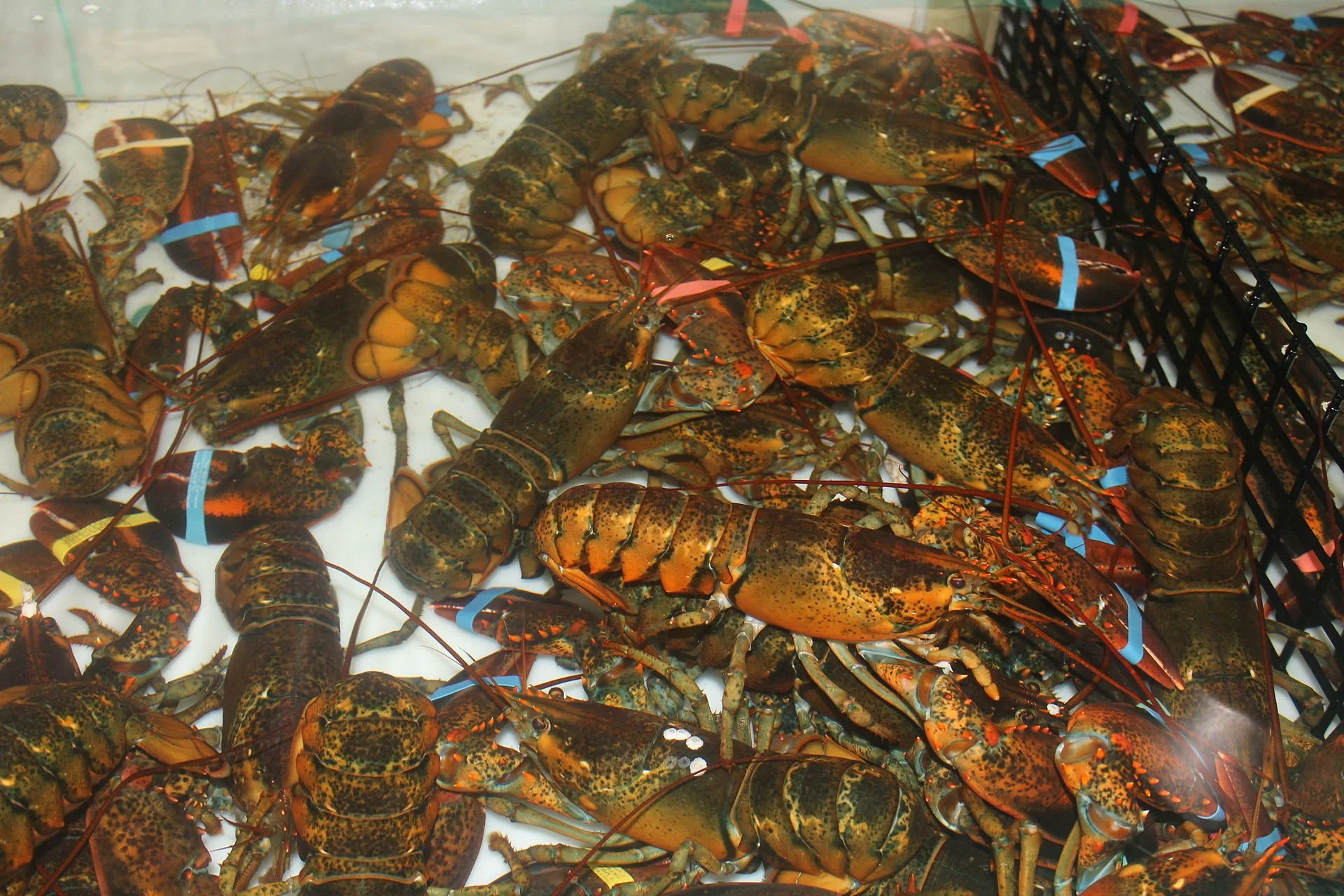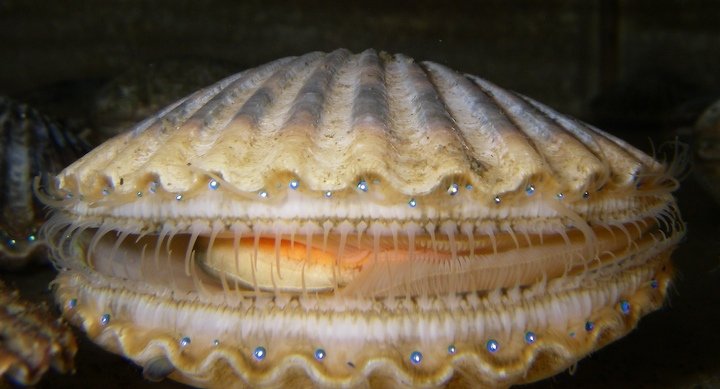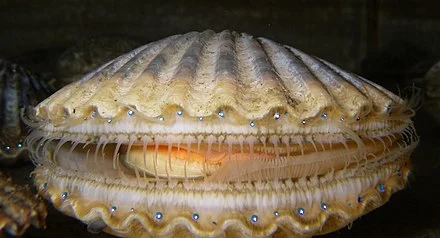
Ocean warming to continue to move lobster, scallop habitats
Lobsters awaiting purchase in Trenton, Maine.
— Photo by Billy Hathorn
An Atlantic Bay Scallop.
From ecoRI News (ecori.org)
Researchers have projected significant changes in the habitat of commercially important American lobster and sea scallops along the Northeast continental shelf. They used a suite of models to estimate how species will react as waters warm. The researchers suggest that American lobster will move further offshore and sea scallops will shift to the north in the coming decades. {Editor’s note: New Bedford is by far the largest port for the sea-scallop fishery.}
The study’s findings were published recently in Diversity and Distributions. They pose fishery-management challenges as the changes can move stocks into and out of fixed management areas. Habitats within current management areas will also experience changes — some will show species increases, others decreases and others will experience no change.
“Changes in stock distribution affect where fish and shellfish can be caught and who has access to them over time,” said Vincent Saba, a fishery biologist in the Ecosystems Dynamics and Assessment Branch at the Northeast Fisheries Science Center and a co-author of the study. “American lobster and sea scallops are two of the most economically valuable single-species fisheries in the entire United States. They are also important to the economic and cultural well-being of coastal communities in the Northeast. Any changes to their distribution and abundance will have major impacts.”
Saba and colleagues used a group of species distribution models and a high-resolution global climate model. They projected the possible impact of climate change on suitable habitat for the two species in the large Northeast continental shelf marine ecosystem. This ecosystem includes waters of the Gulf of Maine, Georges Bank, the Mid-Atlantic Bight and off southern New England.
The high-resolution global-climate model generated projections of future ocean-bottom temperatures and salinity conditions across the ecosystem, and identified where suitable habitat would occur for the two species.
To reduce bias and uncertainty in the model projections, the team used nearshore and offshore fisheries independent trawl survey data to train the habitat models. Those data were collected on multiple surveys over a wide geographic area from 1984 to 2016. The model combined this information with historical temperature and salinity data. It also incorporated 80 years of projected bottom temperature and salinity changes in response to a high greenhouse-gas emissions scenario. That scenario has an annual 1 percent increase in atmospheric carbon dioxide.
American lobsters are large, mobile animals that migrate to find optimal biological and physical conditions. Sea scallops are bivalve mollusks that are largely sedentary, especially during their adult phase. Both species are affected by changes in water temperature, salinity, ocean currents and other oceanographic conditions.
Projected warming for the next 80 years showed deep areas in the Gulf of Maine becoming increasingly suitable lobster habitat. During the spring, western Long Island Sound and the area south of Rhode Island in the southern New England region showed habitat suitability. That suitability decreased in the fall. Warmer water in these southern areas has led to a significant decline in the lobster fishery in recent decades, according to NOAA Fisheries.
Sea-scallop distribution showed a clear northerly trend, with declining habitat suitability in the Mid-Atlantic Bight, southern New England and Georges Bank areas.
“This study suggests that ocean warming due to climate change will act as a likely stressor to the ecosystem’s southern lobster and sea-scallop fisheries and continues to drive further contraction of sea scallop and lobster habitats into the northern areas,” Saba said. “Our study only looked at ocean temperature and salinity, but other factors such as ocean acidification and changes in predation can also impact these species.”
Environmental factors in decline of shellfish along East Coast
Bay scallop.
Via ecoRI News (ecori.og)
Researchers studying the sharp decline between 1980 and 2010 in documented landings of the four most commercially important bivalve mollusks — eastern oysters, northern quahogs, soft-shell clams and northern bay scallops — have identified the causes.
Warming ocean temperatures associated with a positive shift in the North Atlantic Oscillation (NAO), which led to habitat degradation including increased predation, are the key reasons for the decline of these four species in estuaries and bays from Maine to North Carolina, according to the National Oceanic and Atmospheric Administration (NOAA).
The NAO is an irregular fluctuation of atmospheric pressure over the North Atlantic Ocean that impacts both weather and climate, especially in the winter and early spring in eastern North America and Europe. Shifts in the NAO affect the timing of species’ reproduction and growth, the availability of phytoplankton for food, and predator-prey relationships, all of which contribute to species abundance. The findings appear in Marine Fisheries Review.
“In the past, declines in bivalve mollusks have often been attributed to overfishing,” said Clyde Mackenzie, a shellfish researcher at NOAA Fisheries’ James J. Howard Marine Sciences Laboratory, in Sandy Hook, N.J., and lead author of the study. “We tried to understand the true causes of the decline, and after a lot of research and interviews with shellfishermen, shellfish constables, and others, we suggest that habitat degradation from a variety of environmental factors, not overfishing, is the primary reason.”
Mackenzie and co-author Mitchell Tarnowski, a shellfish biologist with the Maryland Department of Natural Resources, provide details on the declines of these four species. They also note the related decline by an average of 89 percent in the numbers of shellfishermen who harvested the mollusks. The landings declines between 1980 and 2010 are in contrast to much higher and consistent shellfish landings between 1950 and 1980.
Exceptions to these declines have been a sharp increase in the landings of northern quahogs in Connecticut and American lobsters in Maine. Landings of American lobsters from southern Massachusetts to New Jersey, however, have fallen sharply as water temperatures in those areas have risen.
“A major change to the bivalve habitats occurred when the North Atlantic Oscillation index switched from negative during about 1950 to 1980, when winter temperatures were relatively cool, to positive, resulting in warmer winter temperatures from about 1982 until about 2003,” Mackenzie said. “We suggest that this climate shift affected the bivalves and their associated biota enough to cause the declines.”
This graph shows the rise and fall of soft-shell clam landings from 1950 to 2005. (Clyde Mackenzie)
Research from extensive habitat studies in Narragansett Bay and in the Netherlands, where environments including salinities are very similar to the northeastern United States, show that body weights of the bivalves, their nutrition, timing of spawning, and mortalities from predation were sufficient to force the decline. Other factors likely impacting the decline were poor water quality, loss of eelgrass in some locations for larvae to attach to and grow, and not enough food available for adult shellfish and their larvae.
“In the Northeast U.S., annual recruitments of juvenile bivalves can vary by two or three orders of magnitude,” said Mackenzie, who has been studying bay scallop beds on Martha’s Vineyard with local shellfish constables and fishermen monthly during warm seasons for several years.
In late spring to early summer of this year, a cool spell combined with extremely cloudy weather may have interrupted scallop spawning, leading to what looks like poor recruitment this year. Last year, Nantucket and Martha’s Vineyard had very good harvests due to large recruitments in 2016.
“The rates of survival and growth to eventual market size for shellfish vary as much as the weather and climate,” Mackenzie said.
Weak consumer demand for shellfish, particularly oysters, in the 1980s and early 1990s has shifted to fairly strong demand as strict guidelines were put in place by the Interstate Shellfish Sanitation Conference in the late 1990s regarding safe shellfish handling, processing, and testing for bacteria and other pathogens.
Enforcement by state health officials has been strict. The development of oyster aquaculture and increased marketing of branded oysters in raw bars and restaurants has led to an increase in oyster consumption in recent years.
Since the late 2000s, the NAO index has generally been fairly neutral, neither very positive nor negative. As a consequence, landings of all four shellfish species have been increasing in some locations. Poor weather for bay scallop recruitment in both 2017 and 2018, however, will likely mean a downturn in landings during the next two seasons.
Diversified fishing; Shifting away from the Sunbelt
Cultured sea scallop.
From Robert Whitcomb’s “Digital Diary,’’ in GoLocal24.com
A wonderful story and video by Maine Public Radio’s Fred Bever describes how Maine fishermen are diversifying to address the challenges posed by overfishing and global warming.
Mr. Bever writes:
“These days it’s mostly lobster, but he {fisherman Marsden Brewer} has fished cod and shrimp, and carted urchin to market. They were all once-vibrant species, but now they’re mostly off-limits after being overfished and weakened by climate change.’’ And Mr. Brewer has moved in a big way into scallop aquaculture.
Jon Gorman, who works at Bangs Islands Mussels, told Mr. Bever:
“I see a lot of growth and you never know. We’re going to be doing scallops, then we’ll be back to mussels, and then the springtime and fall we’re into kelp. It’s fun.”
There are some good ideas in the story for southern New England fishermen.
To see and hear Mr. Bever’s report, please hit this link.
As global warming intensifies, and extreme storms, drought and floods ravage some areas, some predict a reverse migration of people from the southern and western U.S. to such places as the Upper Midwest and inland (!) New England, whose climates are expected to remain relatively moderate and that will continue to have lots of fresh water, which is actually better to have than oil, coal and natural gas!
The big population move to the Sunbelt, with all its socio-economic and political effects, may reverse in the next couple of decades – or before.
By the way, water temperatures in the Gulf of Mexico are four degrees warmer than “normal’’. They’ve often been warmer than “normal’’ for some years now, and at the moment are about 85 degrees. This means more fuel for hurricanes – e.g., Hurricane Michael. Keep burning those fossil fuels and maybe we can get the Gulf up to 95 degrees in the summer in a couple of decades. There won’t be much sea life left, but it will be perfect for a soothing swim. To read more, please hit this link.
Raising tuna at URI
These yellowfin tuna are schooling in the ocean. Other yellowfin tuna are schooling in a giant tank at URI's School of Oceanography. It's exciting to watch.
Expanded from an item in Robert Whitcomb's Dec. 31 '"Digital Diary'' column in GoLocal24.com
Thank God for scallops. These shellfish have been a boon for New England fishermen– an offset to the tendency of fishermen to fish to near-extinction finfish, such as as cod, off New England to meet the world’s rapidly growing appetite for seafood.
But there may soon be big reinforcements for New England's fishing sector and they start on land. Experts in a facility on the campus of the University of Rhode Island School of Oceanography are raising yellowfin tuna in an exciting and potentially very lucrative aquaculture experiment. I recently had a tour of the URI Bay Campus facility, which has a giant tank where this is taking place. To see the tuna school in the tank is, well, neat.
If this experiment works, it could mean a lot of money for URI and for businesses, based, let us hope, in New England. Most of the aquaculture in southern New England has been with shellfish; there's been some salmon aquaculture in Maine. It’s nice to see more diversification.






